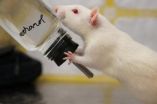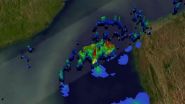(Press-News.org) As recovering spring breakers are regretting binge drinking escapades, it may be hard for them to appreciate that there is a positive side to the nausea, sleepiness, and stumbling. University of Utah neuroscientists report that when a region of the brain called the lateral habenula is chronically inactivated in rats, they repeatedly drink to excess and are less able to learn from the experience. The study, published online in PLOS ONE on April 2, has implications for understanding behaviors that drive alcohol addiction.
While complex societal pressures contribute to alcoholism, physiological factors are also to blame. Alcohol is a drug of abuse, earning its status because it tickles the reward system in the brain, triggering the release of feel-good neurotransmitters. The dreaded outcomes of overindulging serve the beneficial purpose of countering the pull of temptation, but little is understood about how those mechanisms are controlled.
U of U professor of neurobiology and anatomy Sharif Taha, Ph.D. and colleagues, tipped the balance that reigns in addictive behaviors by inactivating in rats a brain region called the lateral habenula. When the rats were given intermittent access to a solution of 20% alcohol over several weeks, they escalated their alcohol drinking more rapidly, and drank more heavily than control rats.
"In people, escalation of intake is what eventually separates a social drinker from someone who becomes an alcoholic," said Taha. "These rats drink amounts that are quite substantial. Legally they would be drunk if they were driving,"
The lateral habenula is activated by bad experiences, suggesting that without this region the rats may drink more because they fail to learn from the negative outcomes of overindulging. The investigators tested the idea by giving the rats a desirable, sweet juice then injecting them with a dose of alcohol large enough to cause negative effects.
"It's the same kind of learning that mediates your response in food poisoning. You taste something and then you get sick, and then of course you avoid that food in future meals," explained Taha.
Yet rats with an inactivated lateral habenula sought out the juice more than control animals, even though it meant a repeat of the bad experience.
"The way I look at it is the rewarding effects of drinking alcohol compete with the aversive effects," explained Andrew Haack, who is co-first author on the study with Chandni Sheth, both neuroscience graduate students. "When you take the aversive effects away, which is what we did when we inactivated the lateral habenula, the rewarding effects gain more purchase, and so it drives up drinking behavior."
The group's findings may help explain results from previous clinical investigations demonstrating that men who were less sensitive to the negative effects of alcohol drank more heavily, and were more likely to become problem drinkers later in life.
The researches think the lateral habenula likely works in one of two ways. The region may regulate how badly an individual feels after over-drinking. Alternatively, it may control how well an individual learns from their bad experience. Future work will resolve between the two.
"If we can understand the brain circuits that control sensitivity to alcohol's aversive effects, then we can start to get a handle on who may become a problem drinker," said Taha.
INFORMATION:
Listen to an interview with Sharif Taha on The Scope Radio
Read the article in PLOS ONE
Funding support was provided by the National Institutes Health under award MH094870, the March of Dimes Foundation, and the University of Utah.
A brain region for resisting alcohol's allure
University of Utah neuroscientists finds the lateral habenula controls sensitivity to the negative effects of drinking alcohol
2014-04-03
ELSE PRESS RELEASES FROM THIS DATE:
Magnetic anomaly deep within Earth's crust reveals Africa in North America
2014-04-02
Boulder, Colo., USA – The repeated cycles of plate tectonics that have led to collision and assembly of large supercontinents and their breakup and formation of new ocean basins have produced continents that are collages of bits and pieces of other continents. Figuring out the origin and make-up of continental crust formed and modified by these tectonic events is a vital to understanding Earth's geology and is important for many applied fields, such as oil, gas, and gold exploration.
In many cases, the rocks involved in these collision and pull-apart episodes are still ...
NASA releases images of M-class solar flare
2014-04-02
On April 2, 2014, the sun emitted a mid-level solar flare, peaking at 10:05 a.m. EDT, and NASA's Solar Dynamics Observatory captured imagery of the event. Solar flares are powerful bursts of radiation. Harmful radiation from a flare cannot pass through Earth's atmosphere to physically affect humans on the ground, however -- when intense enough -- they can disturb the atmosphere in the layer where GPS and communications signals travel.
To see how this event may impact Earth, please visit NOAA's Space Weather Prediction Center at http://spaceweather.gov, the U.S. government's ...
NASA sees Tropical Cyclone's Hellen's lively remnants
2014-04-02
Powerful Tropical Cyclone Hellen rapidly weakened after hitting northwestern Madagascar but Hellen's remnants have recently started to show signs of life. The TRMM satellite flew over these remnants in the Mozambique Channel on April 2, 2014 at 0143 UTC.
A rainfall analysis using the Tropical Rainfall Measuring Mission's (TRMM) Microwave Imager (TMI) and Precipitation Radar (PR) instruments found that some strong convective thunderstorms had developed in the area. It was revealed by TRMM PR data that rain was falling at a rate of over 75 mm/~ 3 inches in a few locations.
TRMM's ...
River ice reveals new twist on Arctic melt
2014-04-02
A new study led by Lance Lesack, a Simon Fraser University geographer and Faculty of Environment professor, has discovered unexpected climate-driven changes in the mighty Mackenzie River's ice breakup. This discovery may help resolve the complex puzzle underlying why Arctic ice is disappearing more rapidly than expected.
Lesack is the lead author on Local spring warming drives earlier river-ice breakup in a large Arctic delta. Published recently in Geophysical Research Letters, the study has co-authors at Wilfrid Laurier University, the University of Alberta and Memorial ...
Body odor changes following vaccination
2014-04-02
PHILADELPHIA (April 2, 2014) – Our understanding of the role of body odor in conveying personal information continues to grow. New research from the Monell Chemical Senses Center and the U.S. Department of Agriculture (USDA) reveals that immunization can trigger a distinct change in body odor. This is the first demonstration of a bodily odor change due to immune activation.
The findings will appear in the April 10 issue of Physiology and Behavior. In addition, portions of the work will be presented on April 10 at the 36th Annual Meeting of the Association for Chemoreception ...
Science-themed music videos boost scientific literacy, study shows
2014-04-02
As the United States puts ever-greater emphasis on science, technology, engineering and mathematics education to keep competitive in the global economy, schools are trying to figure out how to improve student learning in science.
University of Washington researchers Katie Davis and Greg Crowther think music may be the answer for some kids. They studied the ability of music videos to enhance students' understanding of scientific concepts.
Davis will present "Sing about Science: Leveraging the Power of Music to Improve Science Education" on Friday (April 4) at the American ...
Gauging the impact of tropical forest logging: Winrock develops new method for quantifying carbon emissions
2014-04-02
ARLINGTON, Va. (April 2, 2014) — Researchers at Winrock International have developed a first-of-its-kind method for estimating carbon emissions from forest degradation caused by selective logging in tropical regions. Refined over a period of 15 years and tested in six countries, the approach is highlighted in an article authored by Winrock's Ecosystems Services experts, Timothy Pearson, Sandra Brown and Felipe Casarim — published April 1 in Environmental Research Letters.
Until now, efforts for reducing emissions from deforestation and forest degradation (REDD+) in developing ...
NIST's simple microfluidic devices now have valves
2014-04-02
Researchers at the National Institute of Standards and Technology (NIST) have added yet another innovation—miniature valves—to their ever-growing collection of inexpensive, easy-to-manufacture and highly efficient microfluidic devices made from plastic films and double-sided tape.
Traditionally, microfluidic devices—tiny gadgets with fluid-carrying channels used in medical diagnostics, DNA forensics and "lab-on-a-chip" chemical analyzers—have been fabricated like microchips using photolithography. A desired pattern of micrometer-sized channels and ports is created on ...
To boldly go? Experts issue ethics guidelines for NASA's next generation of risky missions
2014-04-02
Nearly two years after the conclusion of its space shuttle program left Americans wondering what would become of the spacefaring dreams of decades past, NASA has sought the advice of health and ethics experts for protecting astronauts on its "next generation" of long duration and exploration-class human spaceflights.
Such missions, including extended stays on the International Space Station and flights to Mars, have higher risks and are unlikely to meet the space agency's current health standards. Options not on the table, according to the Institute of Medicine (IOM) ...
Notre Dame researchers provide new insights into quantum dynamics and quantum chaos
2014-04-02
A team of researchers led by University of Notre Dame physicist Boldizsar Janko has announced analytical prediction and numerical verification of novel quantum rotor states in nanostructured superconductors.
The international collaborative team points out that the classical rotor, a macroscopic particle of mass confined to a ring, is one of the most studied systems in classical mechanics. In a paper appearing in the April 1 issue of the journal Nature Scientific Reports, Janko and colleagues Shi-Hsin Lin, Milorad Milosevic, Lucian Covaci and Francois Peeters of the Universiteit ...
LAST 30 PRESS RELEASES:
Scalable and healable gradient textiles for multi‑scenario radiative cooling via bicomponent blow spinning
Research shows informed traders never let a good climate crisis go to waste
Intelligent XGBoost framework enhances asphalt pavement skid resistance assessment
Dual-function biomaterials for postoperative osteosarcoma: Tumor suppression and bone regeneration
New framework reveals where transport emissions concentrate in Singapore
NTP-enhanced lattice oxygen activation in Ce-Co catalysts for low-temperature soot combustion
Synergistic interface engineering in Cu-Zn-Ce catalysts for efficient CO2 hydrogenation to methanol
COVID-19 leaves a lasting mark on the human brain
Scientists use ultrasound to soften and treat cancer tumors without damaging healthy tissue
Community swimming program for Black youth boosts skills, sense of belonging, study finds
Specific depressive symptoms in midlife linked to increased dementia risk
An ‘illuminating’ design sheds light on cholesterol
Who is more likely to get long COVID?
Study showcases resilience and rapid growth of “living rocks”
Naval Research Lab diver earns Office of Naval Research 2025 Sailor of the Year
New Mayo-led study establishes practical definition for rapidly progressive dementia
Fossil fuel industry’s “climate false solutions” reinforce its power and aggravate environmental injustice
Researchers reveal bias in a widely used measure of algorithm performance
Alcohol causes cancer. A study from IOCB Prague confirms damage to DNA and shows how cells defend against it
Hidden viruses in wastewater treatment may shape public health risks, study finds
Unlock the power of nature: how biomass can transform climate mitigation
Biochar reshapes hidden soil microbes that capture carbon dioxide in farmland
Reducing saturated fat intake shows mortality benefit, but only in high-risk individuals
Manta rays create mobile ecosystems, study finds
Study: Mixed results in using lipoic acid to treat progressive multiple sclerosis
Norbert Holtkamp appointed director of Fermi National Accelerator Laboratory
New agentic AI platform accelerates advanced optics design
Biologists discover neurons use physical signals — not electricity — to stabilize communication
Researchers discover that a hormone can access the brain by hitchhiking
University of Oklahoma researcher awarded funding to pursue AI-powered material design
[Press-News.org] A brain region for resisting alcohol's allureUniversity of Utah neuroscientists finds the lateral habenula controls sensitivity to the negative effects of drinking alcohol




